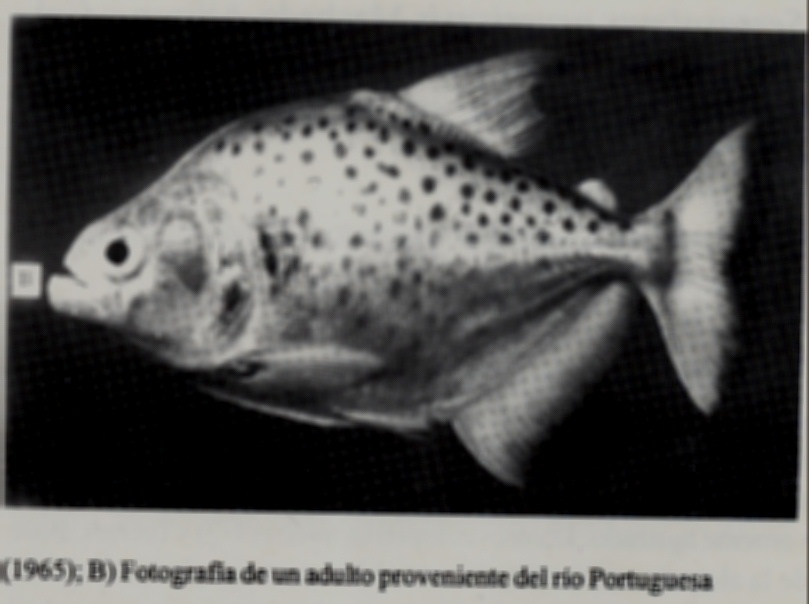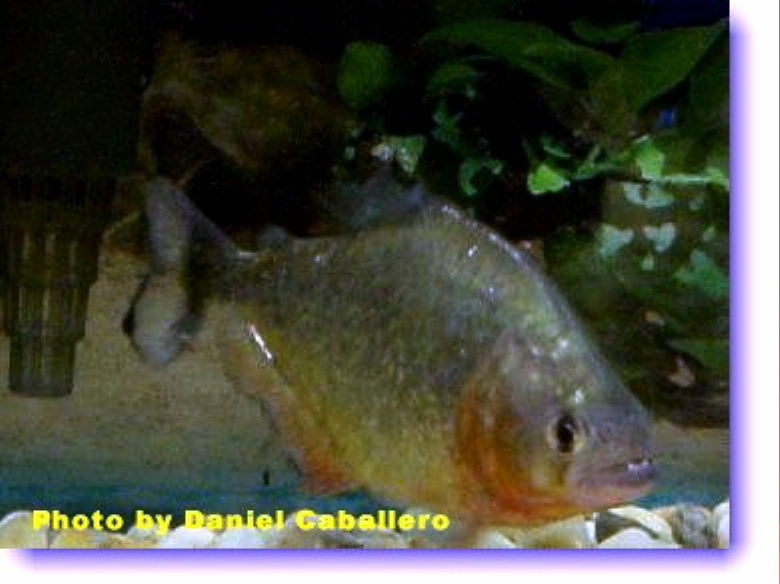|
Video courtesy of Edouard Paiva |
Caribito or Palometa Serrasalmus medinai Ramirez 1965 |
From Frank Magallanes
CARIBITO - Little is known of this species in the home aquarium. It is an aggressive fin biter and probably best to keep as a solitary species in the home aquarium. The aquarium care is probably no different than other Serrasalmus species, however, mixing this species with other related piranhas might not be a good idea.
This species closely resembles the Venezuelan P. cariba (Machado-Allison and Fink 1996) in juvenile forms.The species can be identified by the following combination of characters: Head robust and wide; Mandible short and prominent. Bulldog like muzzle. Ectopterygoid teeth (5-8) numerous and strong. Dorsal fin base is moderate sized, with rays numbering 12-14, usually 13). Base of the adipose fin is prominent. Pre-anal spine is present.
Vertebrates 34-36, usually 35. Numerous small scales. Lateral line 63-75, usually 70. Pre-pelvic serrae 20-25, usually 23 post-pelvic 8-11, usually 10. Branched spines short and the base wide, 17-19, usually 18.
|
S. medinai, Los Peces Caribes de Venezuela - Machado-Allison y Fink |
Photo courtesy of Edouard Paiva from Venezuela |
Photo courtesy of Edouard Paiva from Venezuela |
First live hobbyist photos of S. medinai Photo courtesy of Daniel Caballero |
First live hobbyist photo of S. medinai Photo by Daniel Caballero |
First live hobbyist photos of S. medinai, Caracas, Venezuela. Photo by Daniel Caballero |
Color of life
The body is generally silvery with
numerous, large black spots similar to P. cariba and
S. neveriensis,
diminishing in size nearing the ventral region. A large, humeral blotch is
located near the opercula aperture. Ventral region is metallic reddish-orange in
adults, silvery in juveniles. The head is silvery-yellowish in the lateral and
lateroventral region; iris is yellow; a dark band transects the pupil orbit. The
opercula has a round blemish ventrally. Dorsal region is darkish. Anal fin,
generally (upper, fleshy part) has a black band consisting of tiny scales,
middle darkish reddish-brown anteriorly, with a black band edging of fin. Caudal
third posterior is black; Peduncle region with a broad black band and clear.
Pectoral fins lightly reddish in adults and hyaline in juveniles. Dorsal and
pelvic fins hyaline.
Like other descriptions by Ramirez (1965) the described types are difficult to localize based on his analysis. As stated above, this species is very similar appearing to P. cariba. The morphometric in reference to coloration is very close. The juveniles are difficult to separate using the diagnostic characters, except for the ectopterygoid teeth which P. cariba lacks. The color of juveniles including the coloration of the pectoral, pelvic and anal fin are bright red, similar to the earliest juvenile colors of P. cariba. The only major difference in comparison to S. medinai is having more tiny and numerous spotting, while S. neveriensis has fewer (Machado-Allison, 1996).
SIZE and LOCALITY
Not particularly a large pirambeba 14.8 cm SL, it is one of the prettier ones. Takes along time for it to reach its adult size. Locality: Venezuela - Guarico - - El Polvero, Río San José.
REFERENCES
-
Ramirez, M.V. . 1965 Evencias/Contribuciones ocasionales de la Colección Ictiologica Agustín Fernández Yépez. Evencias. 15:1-4, «Serrasalmus medinai» un nuevo serrasalmido procedente de Venezuela.
-
Machado-Allison, Antonio and Fink, William. 1996 Los Peces Caribes De Venezuela, Dianosticos, Claves, Aspectos Ecologicos Y Evolutivos. pg 60-63.
USE YOUR BACKSPACE TO RETURN OR CLICK HERE TO RETURN SERRASALMUS LIST
USE THIS LINK TO RETURN TO RESEARCH PAGE.
TO RETURN HOME CLICK HERE.
The OPEFE web site and its contents; is disclaimed for purposes of Zoological Nomenclature in accordance with the International Code of Zoological Nomenclature, Fourth Edition, Article 8.3 and 8.4. No new names or nomenclature changes are available from statements at this web site.
Copyright© 1994-2012 Oregon Piranha Exotic Fish Exhibit (The OPEFE fish exhibit is permanently CLOSED as of 2000) Sutherlin, Oregon. Information posted on this web site is archival data on fish scientific classifications and other information. DISCLAIMER: The copyrighted material may not be used for any purpose other than private study, scholarship or research. Cited information requires credit and this link www.opefe.com. All rights reserved. All images shown (unless otherwise noted) is property of OPEFE.
UPDATED: 09/11/2012



